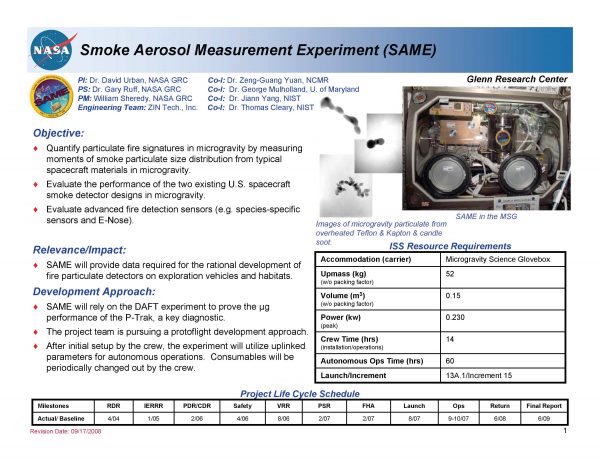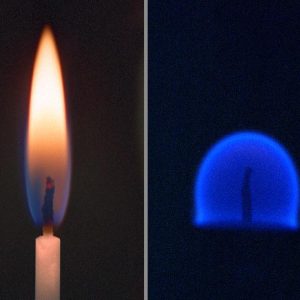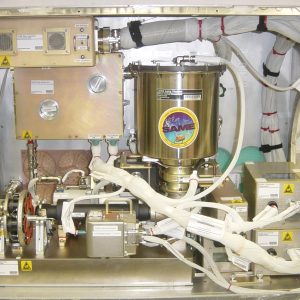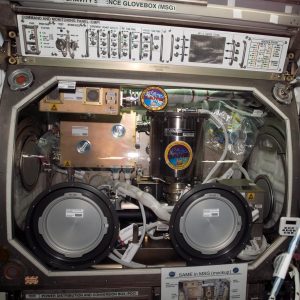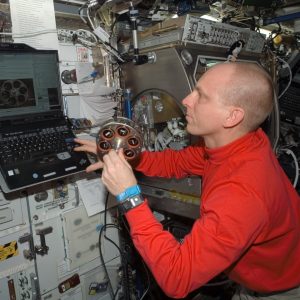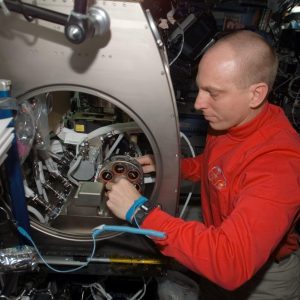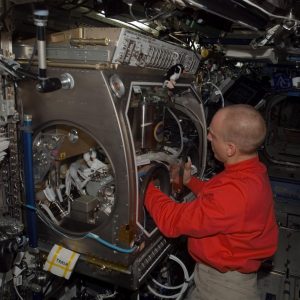SAME
Smoke Aerosol Measurement Experiment (SAME)
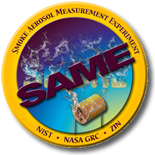 Spacecraft smoke detectors must detect different types of smoke. For example, hydrocarbon fuels typically produce soot and plastics produce droplets of recondensed polymer fragments. While paper and silicone rubber produce smoke comprised of liquid droplets of recondensed pyrolysis products. Each of these materials produces a different type of smoke, with particles of various sizes and properties.
Spacecraft smoke detectors must detect different types of smoke. For example, hydrocarbon fuels typically produce soot and plastics produce droplets of recondensed polymer fragments. While paper and silicone rubber produce smoke comprised of liquid droplets of recondensed pyrolysis products. Each of these materials produces a different type of smoke, with particles of various sizes and properties.
Smoke and Aerosol Measurement Experiment (SAME) will assess the size and distribution of smoke particles produced by different types of material found on spacecraft such as, Teflon, Kapton, cellulose and silicone rubber. SAME will evaluate the performance of the ionization smoke detectors (used on Space Shuttles), evaluate the performance of the photoelectric smoke detectors (used on the ISS) and collect data for which a numerical formula can be developed and used to predict smoke droplet growth and to evaluate alternative smoke detection devices on future spacecraft.
The experimental design and practical application of the data will be complemented by the development of a numerical code to predict the smoke droplet growth as a function of the fuel pyrolysis rate, the thermodynamic properties of pyrolysis vapor, and the flow environment. SAME also has the capability to evaluate other fire detection/particulate sensing devices for the test materials. The results will provide statistics of the smoke particulate size distribution for a range of smoke generation conditions and measurement of a readily modeled reference for validation of smoke growth models.
Research Overview
- Fire is commonly detected by measuring changes in the amount of airborne microscopic particles (one of the components of smoke).
- Smoke detectors currently in use on ISS and Space Shuttle are based on detectors used on Earth that detect different sizes of smoke particles.
- SAME will measure the distribution of particle sizes in smoke from on-orbit combustion of several materials found in the spacecraft. Testing will also examine the effects of sample temperature, air flow and smoke residence time (near the source) on the particle size distribution of the smoke.
- Results will allow an evaluation of the performance in microgravity of the two existing U.S. spacecraft smoke detector designs, in use on the Shuttle and ISS, and evaluate other fire detection devices.
- Information from this experiment will improve the design requirements for and reliability of smoke detectors on future spacecraft.
Space Applications
The SAME experiment will provide technology for an advanced fire detector for future spacecraft that will be used for long duration missions. SAME will provide quantitative data on the sensitivity of these detectors to reduced gravity smokes that will allow evaluation of the adequacy of these existing technologies using relevant data. The current Fire Prevention, Detection, and Suppression (FPDS) program plan allows for the re-evaluation of future sensor technology, to allow new technology and capability to be utilized. The results from SAME are needed to provide the reduced gravity baseline data against which future detection technology developments can be evaluated.
Earth Applications
The smoke detectors developed from the results of SAME can also be useful in other extreme environments on Earth, such as submarines or underwater laboratories. Accurate detection of smoke in these environments can save lives.
Publications
The Smoke and Aerosol Measurement Experiment (SAME) was conducted in the Microgravity Science Glovebox (MSG) on the International Space Station (ISS) during Expedition 15. Overall, 30 samples were tested comprising of six samples each of five different materials: TeflonTM, KaptonTM, silicone rubber, cellulose, and dibutyl-phthalate (a chemical used to make flexible plastic) deposited on a porous wick. These were tested at different airflow rates, heating temperatures, and smoke aging durations.
Smoke properties from different materials were determined using detectors to measure different particulate sizes and their relative abundances in order to describe the overall smoke distribution. A substantial portion of the aerosol mass is in particles that are larger than 1 micron. Teflon smoke comprised primarily of particles having diameters less than 1 um. The effect of aging is consistent with particle coagulation with limited wall loss, the overall number count decreases substantially while the mass concentrations remain relatively steady. This is reasonable given the broader size distribution for silicone smoke containing significant numbers of both large and small particles. Although the arithmetic mean diameters are all in the 100 to 200 nanometer (nm) range, interpreting particle sizes by only one statistic can be deceptive due to the nature of the particle size distribution. In general, since the mass increases with the cube of the diameter, the larger particles do not affect the arithmetic mean diameter (AMD) as much as they affect the light scattering signal which corresponds with the particle mass. Consequently, although the AMD for silicone rubber is 227 nm, almost half the particle mass is larger than 1000 nm. The lamp wick showed similar behavior in the experiment.
All samples produced significant numbers of sub-micron particulate that are better detected using an ionization smoke detector, however a light scattering detector would perform very well for most of the cases. Depending on the conditions, results suggest broader smoke particulate size distributions can be produced from prefire overheat events, thus detection methods which can measure a wider spectrum of particulate size may show more successful and reliable detection. Spacecraft and associated missions outside of low Earth orbit will require increased reliability of fire detection systems in addition to robust false alarm resistance. Given the constrained space on any spacecraft, the target for the fire detection system is necessarily the early phase and not established flaming fires; consequently, the primary target for detection is the pre-fire heating products and not the soot and ash. This research will help to improve design of future detectors (Urban et al. 2009).
Results Publications
- Meyer ME, Mulholland G, Bryg V, Urban DL, Yuan Z, Ruff GA, Cleary T, Yang J. Smoke characterization and feasibility of the moment method for spacecraft fire detection. Aerosol Science and Technology. 2015 May 4; 49(5): 299-309. DOI: 10.1080/02786826.2015.1025124. DOI: 10.1080/02786826.2015.1025124
- Urban DL, Ruff GA, Brooker JE, Cleary T, Yang J, Mulholland G, Yuan Z. Spacecraft Fire Detection: Smoke Properties and Transport in Low-Gravity. 46th Aerospace Sciences Meeting and Exhibit, Reno, NV. 2008 AIAA 2008-806
- Urban DL, Ruff GA, Sheredy WA, Cleary T, Yang J, Mulholland G, Yuan Z. Properties of Smoke from Overheated Spacecraft Materials in Low-Gravity. 47th Aerospace Sciences Meeting and Exhibit, Orlando, FL. 2009 January 5-8; AIAA-2009-0956
- Mulholland G, Meyer ME, Urban DL, Ruff GA, Yuan Z, Bryg V, Cleary T, Yang J. Pyrolysis smoke generated under low-gravity conditions. Aerosol Science and Technology. 2015 March 6; 49(5): 310-321. DOI: 10.1080/02786826.2015.1025125. DOI: 10.1080/02786826.2015.1025125
- Urban DL, Ruff GA, Mulholland G, Cleary T, Yang J, Yuan Z. Measurement of Smoke Particle Size under Low-Gravity Conditions. SAE International Journal of Aerospace. 2008 June 29; 1(1): 317-324. DOI: 10.4271/2008-01-2089.report number 2008-01-2089. DOI: 10.4271/2008-01-2089
- Meyer ME, Urban DL, Mulholland G, Bryg V, Yuan Z, Ruff GA, Cleary T, Yang J. Evaluation of spacecraft smoke detector performance in the low-gravity environment. Fire Safety Journal. 2018 June 1; 9874-81. DOI: 10.1016/j.firesaf.2018.04.004. DOI: 10.1016/j.firesaf.2018.04.004
Gallery
Contact Information
Principal Investigator(s)
-
- David L Urban, Ph.D., Glenn Research Center, Cleveland, Ohio, United States
Co-Investigator(s)/Collaborator(s)
-
- Zeng-guang Yuan, Glenn Research Center, Cleveland, Ohio, United States
- Jiann Yang, National Institute for Standards and Technology, Gaithersburg, Maryland, United States
- Thomas Cleary, National Institute of Standards and Technology, Gaithersburg, Maryland, United States
- George Mulholland, University of Maryland, College Park, Maryland, United States

